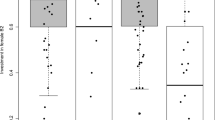Summary
The effects of brood sex-ratio (investment ratio) and the presence of ‘laying workers’ on relatedness in the Hymenoptera are analyzed. It is shown that the conditions of brood composition that generate degrees of relatedness favorable to the evolution of eusocial type helping behavior among females will select against such helping behavior among males, and vice versa (see Fig. 1). Thus, societies in the Hymenoptera can be expected to have male workers or female workers, but not both. It is argued that the conditions leading to degrees of relatedness favorable to male helping are quite restrictive and unlikely to be met in haplodiploid species.
The presence of ‘laying workers’ is shown to lead to biasses in relatedness such that females may be selected to be workers even when the sex-ratio is male-biassed. This result sheds new light on a possible pathway to eusociality in the Hymenoptera. It is argued that ‘offspring parasitism’ of the natal nest may have been important in the evolution of eusociality.
Similar content being viewed by others
References
Alexander RD (1974) The evolution of social behavior. Annu Rev Ecol Syst 5:325–383
Aoki K, Moody M (1981) One- and two-locus models of the origin of worker behavior in Hymenoptera. J Theor Biol 89:449–474
Charnov EL (1978) Evolution of eusocial behavior: offspring choice or parental parasitsm? J Theor Biol 75:451:465
Clark AB (1978) Sex ratio and local resource competition in a prosimian primate. Science 201:163–165
Craig R (1982) Evolution of male workers in the Hymenoptera. J Theor Biol 94:77–94
Crazier RH (1977) The evolutionary genetics of the Hymenoptera. Annu Rev Entomol 22:263–288
Hamilton WD (1964) The genetical evolution of social behavior II. J Theor Biol 7:17–52
Hamilton WD (1967) Extraodinary sex ratios. Science 156:477–487
Hamilton WD (1972) Altruism and related phenomena, mainly in the social insects. Annu Rev Ecol Syst 3:192–232
Hamilton WD (1979) Winglessness and fighting males in fig wasps and other insects. In: Blum MS, Blum NA (eds) Sexual selection and reproductive competition in insects. Academic Press, London, pp 167–220
Hölldobler B (1964) Untersuchungen zum Verhalten der Ameisenmännchen während der imaginalen Lebenzeit. Experientia 20:329–330
Hölldobler B (1966) Futterverteilung durch Männchen in Ameisenstaat. Z Vergl Physiol 52:430–455
Houston TF (1970) Discovery of an apparent male soldier caste in a nest of a halictine bee (Hymenoptera: Halictidae), with notes on the nest. Aust J Zool 18:345–351
LeMasne G (1956) La signification des reproducteurs apteres chez la fourmi Ponera eduardi Forel. Insectes Soc 3:239–259
Lin N, Michener CD (1972) Evolution of sociality in insects. Q Rev Biol 47:131–159
Oster GF, Wilson EO (1978) Caste and ecology in the social insects. Princeton University Press, Princeton, New Jersey, pp 1–352
Pickering J (1980) Larval competition and brood sex ratios in the gregarious parasitoid Pachysomoides stupidus. Nature 283:291
Santschi F (1907) Fourmis de tunise. Rev Suisse Zool 15:305–334
Simon Thomas RT, Poorter AMJ (1972) Notes on the behavior of males of Philanthus triangulum (F.) (Hymenoptera, Sphecidae). Tijdschr Entomol 115:141–151
Trivers RL, Hare H (1976) Haplodiploidy and the evolution of the social insectes. Science 191:249–263
Wilson EO, Hölldobler B (1980) Sex differences in cooperative silk spinning by weaver ant larvae. Proc Natl Acad Sci USA 77:2343–2347
Author information
Authors and Affiliations
Rights and permissions
About this article
Cite this article
Bartz, S.H. On the evolution of male workers in the Hymenoptera. Behav Ecol Sociobiol 11, 223–228 (1982). https://doi.org/10.1007/BF00300065
Received:
Accepted:
Issue Date:
DOI: https://doi.org/10.1007/BF00300065




